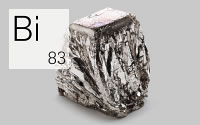- Bismuth: history and industry development
- Bismuth, which has been known since ancient times, was often confused with lead and tin. By the 1400s, people had begun to suspect that bismuth was a distinct chemical element, but it was not isolated until 1753.
 In 1595 Andreas Libavius confused it with antimony, and in 1675 Nicolas Lemery with zinc. These obscurities began to be finally cleared up with the researches of Johann Heinrich Pott (1692-1777), a pupil of Stahl, published in his Exercitationes Chemicae de Wismutho (1769), and of N. Geoffroy, son of Claude Joseph Geoffroy, whose contribution to our knowledge of this metal appeared in the Memoires de l'Academie Francaise of 1753. The French chemist Claude Francois Geoffroy, had shown, in 1753, that bismuth was not a variety of lead or tin, but a separate element. Torbern Olof Bergman reinvestigated its properties and determined its reactions; his account, which was published in his Opuscula, contains the first fairly accurate description of the metal.
In 1595 Andreas Libavius confused it with antimony, and in 1675 Nicolas Lemery with zinc. These obscurities began to be finally cleared up with the researches of Johann Heinrich Pott (1692-1777), a pupil of Stahl, published in his Exercitationes Chemicae de Wismutho (1769), and of N. Geoffroy, son of Claude Joseph Geoffroy, whose contribution to our knowledge of this metal appeared in the Memoires de l'Academie Francaise of 1753. The French chemist Claude Francois Geoffroy, had shown, in 1753, that bismuth was not a variety of lead or tin, but a separate element. Torbern Olof Bergman reinvestigated its properties and determined its reactions; his account, which was published in his Opuscula, contains the first fairly accurate description of the metal.
- The industrial production of the metal began in Saxony around 1830. Claude Joseph Geoffroy is typically given credit for the identification of it as an element. Today, China, Mexico and Peru are the main sources of bismuth.
- Origin of name:The chemical element bismuth was officially discovered in 1753 by French scientist Claude Geoffroy. The origin of the name comes from the German words Weisse Masse meaning white mass. However, around 1400 the element name is already present in some scientific treatises. In fact, before Geoffroy, the Swiss scientist Theophrastus Bombastus von Hohenheim (1493 - 1541), probably better known under his latinized name of Paracelsus, also mentioned the word “Bisemutum”. He said that the latin word came from a german term “Wissmut”. For him, the word “wissmut” was because in Saxony, around St. Georges, the mineral was extracted (gemutet), in the fields (in den Wiesen). For others, the word comes from another similar german word: Weissmuth means 'white material', and this is supported by the fact that bismuth is a bright metal of white colour.
- Bismuth resources can’t be considered as abundant and production is relatively low. In recent years, due to people’s growing awareness of environmental protection, traditional major bismuth producers, including Peru, Mexico and China, have all started to lessen bismuth production.
 Bismuth is produced in several countries with mines in China, Mexico, Peru, and Bolivia and only in Bolivia is it mined as a primary metal--the others get it as a by-product. China, the US, Japan, and the UK and Belgium within the European Union are the major consumers of bismuth. Sidech S.A from Belgium, MCP from the UK, Tasna from Bolivia and Fortune Minerals Ltd. are the most famous companies within the bismuth industry. China is the world’s leader in bismuth mining production, contributing 82% to the world total. Mexico follows it with a 14% share.
Bismuth is produced in several countries with mines in China, Mexico, Peru, and Bolivia and only in Bolivia is it mined as a primary metal--the others get it as a by-product. China, the US, Japan, and the UK and Belgium within the European Union are the major consumers of bismuth. Sidech S.A from Belgium, MCP from the UK, Tasna from Bolivia and Fortune Minerals Ltd. are the most famous companies within the bismuth industry. China is the world’s leader in bismuth mining production, contributing 82% to the world total. Mexico follows it with a 14% share. Concerns over the toxicity of lead usage paved the way towards the evolution of bismuth replacing lead for a variety of applications. Several of the new applications in free machining steels, lead free solders and galvanizing have the size and potential growth to put intense pressure on demand for bismuth. Also, low lead consumption due to lead storage batteries being replaced by alternative batteries (Li-on batteries) adaptable to gasoline powered vehicles could lead to bismuth from tungsten and tin ores and recycling. However, the scattered use of bismuth limits economic production of this metal through recycling. Also, if the bismuth price goes up significantly, it is likely to be challenged by tin and tungsten. Considering the above, demand for bismuth is anticipated to increase with stabilization of prices in the near future.
Concerns over the toxicity of lead usage paved the way towards the evolution of bismuth replacing lead for a variety of applications. Several of the new applications in free machining steels, lead free solders and galvanizing have the size and potential growth to put intense pressure on demand for bismuth. Also, low lead consumption due to lead storage batteries being replaced by alternative batteries (Li-on batteries) adaptable to gasoline powered vehicles could lead to bismuth from tungsten and tin ores and recycling. However, the scattered use of bismuth limits economic production of this metal through recycling. Also, if the bismuth price goes up significantly, it is likely to be challenged by tin and tungsten. Considering the above, demand for bismuth is anticipated to increase with stabilization of prices in the near future.
-
About us
Contact us
Make a suggestion
- Metalpedia is a non-profit website, aiming to broaden metal knowledge and provide extensive reference database to users. It provides users reliable information and knowledge to the greatest extent. If there is any copyright violation, please notify us through our contact details to delete such infringement content promptly.
 In 1595 Andreas Libavius confused it with antimony, and in 1675 Nicolas Lemery with zinc. These obscurities began to be finally cleared up with the researches of Johann Heinrich Pott (1692-1777), a pupil of Stahl, published in his Exercitationes Chemicae de Wismutho (1769), and of N. Geoffroy, son of Claude Joseph Geoffroy, whose contribution to our knowledge of this metal appeared in the Memoires de l'Academie Francaise of 1753. The French chemist Claude Francois Geoffroy, had shown, in 1753, that bismuth was not a variety of lead or tin, but a separate element. Torbern Olof Bergman reinvestigated its properties and determined its reactions; his account, which was published in his Opuscula, contains the first fairly accurate description of the metal.
In 1595 Andreas Libavius confused it with antimony, and in 1675 Nicolas Lemery with zinc. These obscurities began to be finally cleared up with the researches of Johann Heinrich Pott (1692-1777), a pupil of Stahl, published in his Exercitationes Chemicae de Wismutho (1769), and of N. Geoffroy, son of Claude Joseph Geoffroy, whose contribution to our knowledge of this metal appeared in the Memoires de l'Academie Francaise of 1753. The French chemist Claude Francois Geoffroy, had shown, in 1753, that bismuth was not a variety of lead or tin, but a separate element. Torbern Olof Bergman reinvestigated its properties and determined its reactions; his account, which was published in his Opuscula, contains the first fairly accurate description of the metal.
 Bismuth is produced in several countries with mines in China, Mexico, Peru, and Bolivia and only in Bolivia is it mined as a primary metal--the others get it as a by-product. China, the US, Japan, and the UK and Belgium within the European Union are the major consumers of bismuth. Sidech S.A from Belgium, MCP from the UK, Tasna from Bolivia and Fortune Minerals Ltd. are the most famous companies within the bismuth industry. China is the world’s leader in bismuth mining production, contributing 82% to the world total. Mexico follows it with a 14% share.
Bismuth is produced in several countries with mines in China, Mexico, Peru, and Bolivia and only in Bolivia is it mined as a primary metal--the others get it as a by-product. China, the US, Japan, and the UK and Belgium within the European Union are the major consumers of bismuth. Sidech S.A from Belgium, MCP from the UK, Tasna from Bolivia and Fortune Minerals Ltd. are the most famous companies within the bismuth industry. China is the world’s leader in bismuth mining production, contributing 82% to the world total. Mexico follows it with a 14% share. Concerns over the toxicity of lead usage paved the way towards the evolution of bismuth replacing lead for a variety of applications. Several of the new applications in free machining steels, lead free solders and galvanizing have the size and potential growth to put intense pressure on demand for bismuth. Also, low lead consumption due to lead storage batteries being replaced by alternative batteries (Li-on batteries) adaptable to gasoline powered vehicles could lead to bismuth from tungsten and tin ores and recycling. However, the scattered use of bismuth limits economic production of this metal through recycling. Also, if the bismuth price goes up significantly, it is likely to be challenged by tin and tungsten. Considering the above, demand for bismuth is anticipated to increase with stabilization of prices in the near future.
Concerns over the toxicity of lead usage paved the way towards the evolution of bismuth replacing lead for a variety of applications. Several of the new applications in free machining steels, lead free solders and galvanizing have the size and potential growth to put intense pressure on demand for bismuth. Also, low lead consumption due to lead storage batteries being replaced by alternative batteries (Li-on batteries) adaptable to gasoline powered vehicles could lead to bismuth from tungsten and tin ores and recycling. However, the scattered use of bismuth limits economic production of this metal through recycling. Also, if the bismuth price goes up significantly, it is likely to be challenged by tin and tungsten. Considering the above, demand for bismuth is anticipated to increase with stabilization of prices in the near future.